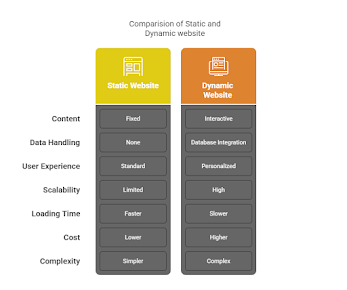Websites and types of websiteIn the digital age, websites serve as essential platforms for communication, commerce, and information dissemination. This document explores the fundamental concepts of websites, focusing on two primary types: static websites and dynamic websites. By understanding these categories, one can better appreciate the underlying technologies and purposes that drive web development.
What is website?
A website is a collection of webpages and related content that is identified by a common domain name and published on web server. Websites are typically dedicated to a particular topic or purpose, such as news, educations, commerce, entertainment or social media.→ A website is a collection of many webpages and webpages are digital files that are written using HTML.
→ A website is a digital platform qaccessible via the internet, serving as a virtual space where individuals, business, or organizations can creat an online presence. It allows them to share information, offers various product or services and connect globally.
→ It typically includes text, images, videos, audios, forms and othe interactive elements.
→ The first page of a website is Home page.
→ The first website info.cern.ch is created by Tim Berners Lee in August-06, 1991 at CERN.
Components of website
→ Website is a collection of webpages hosted on a web server. These are the components for making website.
⤷ Web host: Hosting is the location where the website is physically located. Group of webpages licensed to be called a website only when the webpage is hosted on the webserver.
⤷ Address: Address of a website also known as the URL of a website. To open a website, address or URL of website into the browser and the asked website is delivered by the web browser.
⤷ Home Page: Home page is very common and important part of a webpage. It is the first web page and its direct viewer to the rest of the pages on the website.
⤷ Design: It is the final and overall look and feel of the website that has a result of proper use and integration elements like navigations menu, graphics, layout, etc.
⤷ Content: Every webpages contained on the websites together makup the content of the website. Good content on the webpages make the websites more effective and attractive.
⤷ Navigation Structure: The navigation structure of a website is the order of pages, the collection of what links to what. Usually, it is held together by at least one navigatin menu.
Types of Websites
1. Static Website
⟶ The combination of webpages that are stored in a server in the same format that is sent to a client's web browser is a static website. The Static websites are initially coded in the HTML and CSS that are used to control the appearance beyond basic HTML.
⟶ The static websites are also known as flat or stationary websites.
⟶ It's content does not change unless manually updated by the website owner.
⟶ It is easy to create and cost effective to host since it is not rely on database or CMS.
⟶ It can't take inputs from visitors but may stil contains animations and clickable elements such as hyperlink or navigations buttons.
⟶ It is suitable for displaying portfolios, catalogsites, company brochures, simple informational pages.
⟶ A dynamic website is a website that changes in response to user interactions, offering features such as live inventory display and customize experience for each visitors.
⟶ It is a collection of webpage that change or customizes itself automatically and frequently.
⟶ It can change its content and appearance based on several factors, including time of the day, visitor's location, language preferences and past interactions with the site.
⟶ It generates content dynamically, often using server-side scripting language like PHP, python, ASP.NET, Node.js, etc.
⟶ It is most suited for e-commerce, business, social media, tickets books and forums.
⟶ Examples of dynamic websites are Amazon.com, YouTube, The NewYork Times, Google News, Twitter, Reddit, etc.
In summary, Static websites are ideal for simple, unchanging content, while dynamic websites offer interactivity and personalization for more complex applications. Choosing the right type of website depends on the specific needs and goals of the project.



.png)






0 Comments